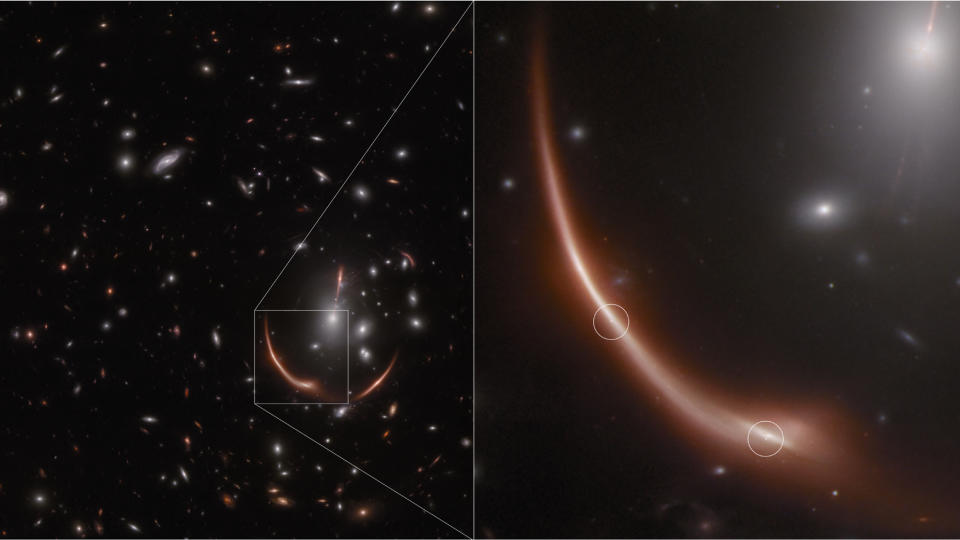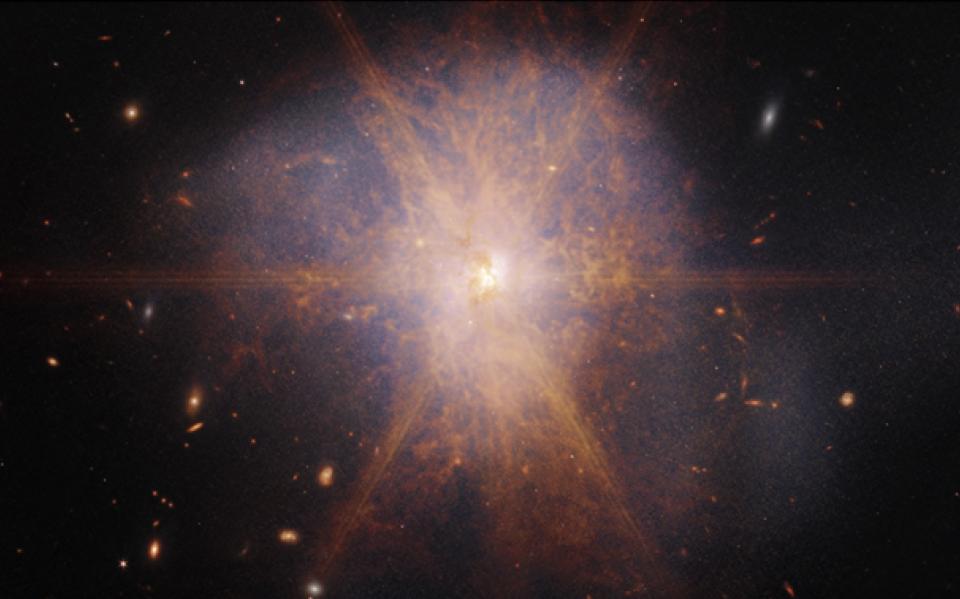What was little more than a speck of light to the Hubble Space Telescope turns out to be one of the oldest galaxies ever discovered — and it owes the finding to none other than Hubble’s little brother, the James Webb Space Telescope.
The James Webb Space Telescope international “Glass” Collaboration has made detailed observations of a galaxy called Gz9p3, which appears to exist just 510 million years after the Big Bang. This is in the relative infancy of the universe, which is currently 13.8 billion years old.
The team found that, like other early galaxies seen by JWST, Gz9p3 is much larger and more mature than expected for a galaxy in the infant universe. By the time it was detected, it already appears to have contained several billion stars.
When it comes to the cosmic puzzle of how early galaxies grew so quickly to become so large, Gz9p3 may be a real enigma. Not only is it larger than expected, it’s also about 10 times larger than other galaxies JWST has seen at similar periods in the universe’s history.
Relating to: James Webb Space Telescope complicates expanding universe paradox by checking Hubble’s operation
“Just a few years ago, Gz9p3 appeared as a single point of light on the Hubble Space Telescope,” team member Kit Boyett, a scientist at the University of Melbourne, wrote for the institute’s Pursuit publication. “But using JWST, we were able to observe this object 510 million years after the Big Bang, approximately 13 billion years ago.”
Gz9p3 is definitely remarkable. In addition to its size and maturity, its shape also gives clues about its creation.
Was Gz9p3 created by an early galaxy merger?
Using JWST and direct imaging, the team was able to determine that Gz9p3 has a complex shape consisting of two bright patches that reveal its two dense cores. This suggests that Gz9p3 was probably created when two early galaxies crashed into each other in the incipient universe. This collision may have been still ongoing when astronomers spotted Gz9p3 with JWST.
“JWST imaging of the galaxy shows a morphology typically associated with two interacting galaxies. And the merger is not over yet because we still see two components,” Boyett said. he explained. “When two massive objects merge in this way, they effectively expel some of the matter in the process. So, this ejected matter suggests that what we are observing is one of the most distant mergers ever seen.”
Boyett and his colleagues were able to probe deeper into Gz9p3 to determine the age, mass, and shape of this ancient galaxy, as well as to study the stellar population of these colliding galaxies. Because young stars are brighter than older stars, they often dominate images of galaxies, especially those whose light is so distant that it has traveled to Earth for billions of years.
“For example, a bright population that is less than a few million years old, emerging from galaxy mergers, dwarfs an older population that is already over 100 million years old,” Boyett continued.
The Glass collaboration sought to solve this problem by taking spectroscopic observations of Gz9p3 and leveraging direct imaging. Spectroscopy can be used to determine the elements that make up stars; Young and old stars have different compositions, allowing researchers to distinguish two categories in this early galaxy.

Older stars have already made their way through the hydrogen in their cores into helium, which they then combine to form even heavier elements that astronomers call “metals.” This means that older stars are richer in metals than younger stars, which are still dominated by hydrogen and some helium.
The study team used JWST to detect specific elements in Gz9p3’s older stellar population. These target elements included silicon, carbon and iron, the heaviest element that can be synthesized by stars. This means that when these stars died in supernova explosions, they enriched the early universe with metals. Much of this metal content would become the building blocks of future generations of stars.
Additionally, the team discovered that the population of old stars in Gz9p3 is much larger than previously suspected. This means that although astronomers are aware of the life and death cycle of stars and the increasing metal enrichment of subsequent star generations, observations of Gz9p3 show that galaxies are “chemically maturing” faster than previously suspected.
“These observations provide evidence of the rapid and efficient formation of stars and metals due to ongoing galaxy mergers immediately after the Big Bang, and show that massive galaxies with several billion stars existed earlier than expected,” Boyett said. he wrote.
A story of violence
Galaxies isolated from their galactic counterparts form stars, but the process is slow and ends when the galaxy exhausts its reserves of gas and dust, the materials that form stars.
For galaxies close together, the star formation process can be accelerated or even revived after stopping. This is because these galaxies collide when brought together by mutual gravitational attraction. The merger then causes an influx of fresh gas, which initiates a period of rapid star birth called a “starburst”; This means that mergers provide an excellent way for galaxies to rapidly grow their stellar populations.


Most of the large galaxies in the universe have grown this way; Our own galaxy, the Milky Way, also has a merger history. For example, it has played a role in cannibalizing smaller satellite galaxies that once orbited it. The Milky Way is currently forming stars at a low rate, but this will change when it collides with our neighboring galaxy Andromeda in about 4.5 billion years. This will cause a flow of gas that will start a new bout of star explosions.
Thanks to observations of Gz9p3, astronomers are getting the message that this channel for rapid mass accretion and star birth was a larger factor in the early universe than previously thought.
Related Stories:
— James Webb Space Telescope focuses on star-forming region in the Triangle Galaxy (images)
— James Webb Space Telescope’s targets for next year include black holes, exomoons, dark energy and more
— James Webb Space Telescope may have found some of the first stars
“These observations of Gz9p3 show that galaxies were able to rapidly accumulate mass through mergers in the early universe, and that their star formation efficiencies were higher than we expected,” explained Boyett. “These and other observations using JWST are causing astrophysicists to change their modeling of the early years of the universe.
“Our cosmology is not necessarily wrong, but our understanding of how fast galaxies form is probably wrong because they are more massive than we believe is possible.”
The team’s research was published March 7 in the journal Nature Astronomy.